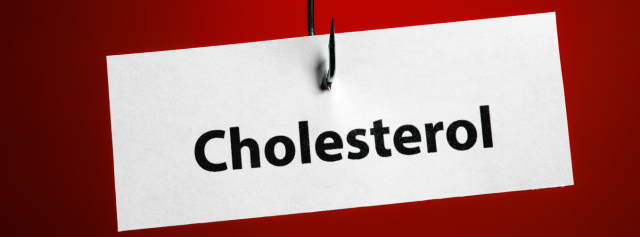 Do you believe—or have you been told—that having “high cholesterol” increases your risk of heart disease?
Do you believe—or have you been told—that having “high cholesterol” increases your risk of heart disease?
Compared to this Advanced Cholesterol Panel, the standard cholesterol panel, which includes Total Cholesterol; LDL (“bad) cholesterol; HDL (“good”) cholesterol and Triglycerides, is woefully inadequate—and outdated—if you are trying to determine your risk for heart disease.
There’s no question that cardiovascular disease (CVD) is the leading cause of death in the U.S. Yet, more than half (51%) of Americans are not aware of this, according to a recent Harris Poll survey conducted on behalf of the American Heart Association in November 2023 (1). Consider the following (2):
-
- On average, someone dies of CVD every 34 seconds in the U.S.
- There are about 1,905 deaths from heart disease, each day in the U.S., including heart attacks.
- Approximately every 40 seconds, someone in the U.S. will have a heart attack.
- Each year in the U.S., there are about 605,000 new heart attacks and 200,000 recurrent attacks. Of these, an estimated 170,000 are silent—without significant symptoms.
Heart health awareness often only begins when people are told that because they have “high cholesterol”, they are at greater risk for heart disease.
Conventional medical doctors are likely to prescribe a statin if your LDL, or “bad” cholesterol, is high.
On a standard lipid panel, the following are considered “ideal” numbers.
-
- Total Cholesterol: <200
- LDL (“bad” cholesterol): <130
- HDL (“good” cholesterol): >50 for women) and >40 for men
- Triglycerides: <150
However, your total cholesterol and LDL numbers are not accurate predictors of heart disease risk. Unfortunately, this is still a widespread belief in the conventional medical establishment.
My High Cholesterol Story
Twelve years ago, I was prescribed a statin by my osteopath because my total cholesterol had crept up from 211 to 294 over a period of two years, and my LDL was 183. Never mind that my HDL was 103 and my triglycerides were 43. At the time, I was very physically fit—running 30 miles a week in addition to weight training—cooking most meals, and I had healthy lifestyle habits.
When my osteopath prescribed a statin, I immediately stopped seeing her. I had zero interest in taking a pharmaceutical drug with a wide range of potential side effects, including headaches; difficulty sleeping; digestive issues; lower back pain; muscle pain; weakness; fatigue; liver damage; kidney failure; cataracts; confusion; memory loss; sexual dysfunction, including impotence; and diabetes (3, 4, 5).
After researching my options, I began working with a functional medicine doctor who did extensive lab work to uncover the root cause of my symptoms. Among the results…my total cholesterol was 334 and my LDL was 185. But, instead of pronouncing me a sure candidate for taking a statin, this functional medicine doctor diagnosed me with Hashimoto’s thyroiditis (autoimmune thyroid dysfunction) and severe adrenal exhaustion. I was prescribed a natural thyroid hormone and supplements to support my adrenal glands. Once I received my diagnosis, I was also proactive about supporting my thyroid and adrenal health. I eliminated specific inflammatory foods from my diet. I prioritized rest and relaxation. I incorporated stress reduction strategies into my lifestyle. After several months, my “high cholesterol” dropped significantly.
What I learned from my “high cholesterol” experience is that, with the exception of genetics, “high cholesterol” is often a proxy for some form of inflammation and/or oxidation happening in your body. Underlying causes for high cholesterol can include (6):
-
-
- Poor thyroid function (as was my case).
- Chronic bacterial or viral infection.
- Metabolic dysfunction, such as insulin resistance or metabolic syndrome.
- Gut dysbiosis (an imbalance of good vs. bad gut bacteria).
- Exposure to environmental toxins in our air, food, water, household and personal care products. For example, heavy metals, such as lead, mercury and/or cadmium (7, 8).
- Taking medications for acne, high blood pressure, cancer, HIV/AIDs, irregular heart rhythms or organ transplants (9).
-
Unfortunately, the conventional medical approach to heart disease is based on faulty, outdated science, otherwise known as the “diet-heart hypothesis” which harks back to the 1950s.
Widely accepted as “fact”—without evidence—for over 60 years, this hypothesis maintains that high cholesterol is a significant risk factor for coronary heart disease. And that saturated fat and cholesterol-rich foods “cause” heart disease by raising serum cholesterol.
How the diet-heart myth started
Ancel Keys, a physiologist who studied the influence of diet on health, first proposed the diet-heart hypothesis in the 1950s. His idea was based on a handful of small feeding experiments conducted on humans, as well as some animal data, that suggested high blood cholesterol caused fatty deposits thought to clog arteries and cause heart attacks (10).
Between 1952 and 1956, Keys conducted informal exploratory studies on the relationship between serum cholesterol levels and heart attack rates (11). In 1958, Keys launched his famous Seven Countries Study (SCS), which followed 12,770 men in 16 locations within seven countries, including Italy, Greece, Yugoslavia, Finland, the Netherlands, Japan and the United States.
A marriage of politics, nutrition and corporate influence
In 1960, Keys was appointed to the American Heart Association’s (AHA) nutrition committee and was able to convince his colleagues to recommend his diet-heart idea—even without firm evidence—as official AHA policy. By 1961, the American Heart Association was recommending that all men (and, later, women) decrease their consumption of saturated fat and to replace these fats with polyunsaturated vegetable oils (e.g., canola, corn, safflower and soybean oils) to protect against heart disease. A conflict of interest worth noting: in 1948, the AHA had received $1.7 million (apx. $20 million in today’s dollars) from Proctor & Gamble, the makers of Crisco oil, a shortening made entirely of “vegetable oils”, marketed today as “cholesterol free” and “gluten-free” (12). Hmmmm.
In 1975, Keys published the results of his Seven Countries Study in the American Heart Association journal, which showed a seemingly strong correlation between consumption of saturated fat and deaths from heart disease (13).
In 1980, the U.S. government adopted the American Heart Association’s advice to limit saturated fat as official policy for all Americans (14).
More recently, in 2020, the AHA, itself, published a meta-analysis of observational studies and randomized controlled trials about the role of saturated fat in “causing” heart disease. The result?
Despite the long-time recommendation to eliminate or reduce red meat, full-fat dairy products, butter and eggs…this meta-analysis found that total dairy, milk, high-fat dairy, cheese, butter, eggs and unprocessed red meats are NOT associated with cardiovascular disease outcomes. Coconut oil, a rich source of saturated fat at 92% of total fat, decreased LDL cholesterol compared with butter and elicited no change in LDL cholesterol compared with olive oil (15).
In the decades following his published results, Keys was—and is—criticized for “cherry-picking” the seven countries and his data to “prove” his hypothesis, also known as confirmation bias. For example, Keys did not include countries like France, Germany or Switzerland, where people consumed large quantities of saturated fat (e.g., cheese, cream, butter and red meat), yet experienced low rates of heart disease—similar to the countries featured in the Seven Countries Study (16).
Remember: correlation does not imply causation. Just because two variables (e.g., high cholesterol and heart disease) seemingly move together in the same direction does not automatically mean that one variable “causes” the other. For example, let’s say both ice cream consumption and murder rates increase dramatically in the summer; should we automatically assume that eating more ice cream “causes” a spike in murders? It’s a ridiculous example, but you get the idea…
Understanding why cholesterol is NOT your enemy
Despite its bad rap, cholesterol is vital to our health. In fact, life as we know it could not exist without cholesterol.
Cardiologist Dr. Stephen Sinatra writes in The Great Cholesterol Myth (17):
“Cholesterol is a basic raw material made by your liver, your brain and virtually every cell in your body. Enzymes convert it into vitamin D, sex hormones (e.g., estrogen, progesterone, and testosterone) as well as stress hormones, and bile salts for digesting and absorbing fats.
The brain is particularly rich in cholesterol and accounts for approximately one-quarter of all the cholesterol we have in our bodies. Neuronal communication depends on cholesterol: lower levels of cholesterol are linked to poorer cognitive performance.”
One adverse side effect of taking cholesterol-lowering statins is memory loss, including fuzzy thinking and/or learning difficulties (18). Personally, I have several friends with a parent now struggling with dementia or Alzheimer’s after taking a statin.
Our immune system also depends on cholesterol because our immune cells require cholesterol for activation; cholesterol can play an important anti-inflammatory role in fighting bacteria and infections (19, 20).
The other important thing to understand about cholesterol?
Only 20% of the cholesterol comes from the foods we eat!! The other 80% is produced inside of our bodies—by the liver (21).
Several cholesterol feeding studies—where volunteers were fed 2 to 4 eggs daily and their cholesterol was measured—have attempted to clarify the relationship between dietary cholesterol and the development of coronary heart disease. What researchers found: Dietary cholesterol has minimal—if any—impact on blood cholesterol levels in roughly 75% of the population.
The other 25% were deemed “hyper responders” because, in this group, dietary cholesterol modestly increased both LDL (“bad” cholesterol) and HDL (“good” cholesterol”); however, dietary cholesterol did not affect the ratio of LDL to HDL or increase the risk of heart disease (22, 23).
Why LDL “bad” cholesterol doesn’t tell the whole story…
It is important to understand: you don’t have a cholesterol level “in your blood”. Cholesterol is a sterol, a combination of a steroid and alcohol. Cholesterol is fat-soluble and blood is mostly water. Cholesterol, itself, can’t travel in the blood because it is hydrophobic, which means it cannot be mixed with—or dissolved in—water. In order for cholesterol to travel anywhere in the body, it has to be encased in a protective structure, which are special proteins called “lipoproteins”. Classified according to their density, LDL (low-density lipoprotein) and HDL (high-density lipoprotein) are the two lipoproteins typically associated with heart disease (24).
Imagine that your bloodstream is a highway. The lipoproteins are the cars that transport its passengers (cholesterol and fats) around your body. It was once commonly believed that the number of passengers in the car (e.g., the concentration of cholesterol in the LDL particle) was a main contributor to the development of heart disease.
However, more recent studies suggest that it is the number of cars on the road (e.g., total number of LDL particles) that matter most (25). In other words, the more cars there are on the highway—visualize rush hour traffic on the LA freeway—the greater your risk of having an accident; the number of passengers—whether it’s 1 person or 4 people—in your car is irrelevant.
Coronary arteries are hollow tubes, and the endothelium (lining) of the artery is only one cell deep—like a very flimsy “guard rail”! The blood, which carries lipoproteins like LDL is in constant contact with the endothelial lining. As a result, the more cars (lipoproteins) are on the highway, the higher the likelihood that some cars will “crash” into the fragile lining of the artery. Again, I’m making the point that knowing the actual number of LDL particles in your bloodstream tells you more about your heart disease risk than a “high” LDL cholesterol number.
Yes, your LDL cholesterol level (LDL-C) can be concordant with your LDL particle number (LDL-P), meaning that when LDL cholesterol is high, LDL particle size is high and vice versa. However, these markers can also be discordant, meaning that your LDL cholesterol (LDL-C) may be “normal” or even “low”, but the number of LDL particles (LDL-P) is “high” (25).
In a study published in the Journal of Clinical Lipidology, researchers recruited 6,814 participants, an ethnically diverse group of men and women, between the ages 45 to 84, who were free of cardiovascular disease (CVD) at the start of the study. Researchers tracked study participants for CVD events: there were 319 cardiac events—including heart attacks, coronary heart disease death, angina (chest pain due to reduced blood flow to the heart), stroke, stroke death or other CVD death—over a 5.5 year period.’’
What researchers found: Concordant LDL-C and LDL-P (in other words, both numbers were high) were associated with increased risk of CVD. However, when the LDL particle number and LDL cholesterol were discordant (for example, “high” LDL particle number vs. a “normal” LDL cholesterol), the LDL particle number was more strongly associated with risk of a CVD event, including heart attack, stroke and death (26).
Get the right cholesterol tests to assess heart disease risk…
Conventional medical doctors still use the standard lipid panel as a basis to determine your risk for heart disease. Keep in mind, too, that financial incentives for prescribing statins play a role in driving the global statin market size, a reported $15.4 billion (US dollars) in 2023 (27).
Did you know: nearly 80% of people with coronary artery disease have standard cholesterol tests that fall within “normal” ranges? This suggests that routine cholesterol tests—established over 50 years ago—fail to identify a large number of people at risk for heart attacks—who, if aware of their risk, could make changes in their food choices and lifestyle habits to reduce their risk of heart disease.
This is why I am a big fan of—and regularly use—this Advanced Cholesterol Panel to stay on top of my heart health—especially because I am hypothyroid and also susceptible to chronic viral infections, like Epstein-Barr, which can be underlying causes of high cholesterol.
The Advanced Cholesterol Panel includes the standard lipid panel PLUS cholesterol markers that more accurately predict your risk of heart disease.
The sale ($155) ends on February 29th. You can purchase the panel now—and schedule your blood draw later—up to 1 year from date of purchase. *Note: This is direct lab testing. Meaning…you order your own labs. No doctor’s visit required. IF you live in New York or New Jersey, you will not be able to access direct lab testing. However, you can order your labs online, then travel to Connecticut, Pennsylvania or Massachusetts (this is where I go) for your blood draw.
You will be emailed your results 1 week from your blood draw. You can then take your labs to the healthcare practitioner of your choice. Or consult with me if you choose.
Click here to order the Advanced Cholesterol Panel.
In addition to the standard lipid panel, the Advanced Cholesterol Panel includes advanced biomarkers like:
–LDL particle number. I’ve covered this at length in this e-newsletter. A high LDL particle number is associated with an increased risk of heart disease.
–Apolipoprotein B: Apolipoprotein B is a protein found on LDL cholesterol particles. A high number of Apo-B containing lipoproteins is associated with more cholesterol ending up in your artery wall. Elevated levels of apolipoprotein B are associated with an increased risk of heart disease and heart attack.
–Lipoprotein (a). A type of LDL cholesterol that, when high, is associated with an increased risk of heart disease.
–Peak size and Pattern. This size and pattern of LDL cholesterol particles provide useful information about your cardiovascular risk. *Small, dense LDL particles are associated with an increased risk of heart disease.
–HDL Large. HDL (“good” cholesterol) large particles are associated with a lower risk of heart disease.
Sources
1, 2 American Heart Association (AHA). 1/24/24.
3 Drugs.com. Side effects of statins. 8/22/23.
4 Heathline.com. Statins: Uses, Risks and Side Effects. 3/29/22.
5, 6, 23, 24, 25 Kresser, C. The Diet-Heart Myth: Learn how to prevent and treat heart disease naturally.
7 NDTV. Increased Exposure To Lead and Mercury May Raise Cholesterol: 5 Good Cholesterol Foods. Nov. 6, 2018.
8 Buhari O, Dayyab FM, Igbinoba O, Atanda A, Medhane F, Faillace RT. The association between heavy metal and serum cholesterol levels in the US population: National Health and Nutrition Examination Survey 2009-2012. Hum Exp Toxicol. 2020 Mar;39(3):355-364.
9 Mayo Clinic. High Cholesterol. Jan 11, 2023.
10, 12, 13, 14, 16 Teicholz N. A short history of saturated fat: the making and unmaking of a scientific consensus. Curr Opin Endocrinol Diabetes Obes. 2023 Feb 1;30(1):65-71.
15 Jeffery L Heileson, Dietary saturated fat and heart disease: a narrative review, Nutrition Reviews, Volume 78, Issue 6, June 2020, Pages 474–485.
17, 20 Bowden, J. and Sinatra, S. The Great Cholesterol Myth: Why Lowering Your Cholesterol Won’t Prevent Heart Disease and the Statin Free Plan That Will. Revised and Expanded. Quarto Publishing Group, 2020.
18 Wenner Moyer, M. (2010, Sept. 1). It’s Not Dementia, It’s Your Heart Medication: Cholesterol Drugs and Memory. Scientific America.
19 Ryan J. King, Pankaj K. Singh, Kamiya Mehla, The cholesterol pathway: impact on immunity and cancer. Trends in Immunology. Volume 43, Issue 1, 2022, Pages 78-92.
21 Corliss, J. (2017, Feb. 6). How it’s made: Cholesterol production in your body. Harvard Health Publishing.
22 Kratz M. Dietary cholesterol, atherosclerosis and coronary heart disease. Handb Exp Pharmacol. 2005;(170):195-213.
26 Otvos JD, Mora S, Shalaurova I, Greenland P, Mackey RH, Goff DC Jr. Clinical implications of discordance between low-density lipoprotein cholesterol and particle number. J Clin Lipidol. 2011 Mar-Apr;5(2):105-13.
27 IMARC. Statin Market Report by Type (Synthetic Statins, Natural Statins), Therapeutic Area (Cardiovascular Disorders, Obesity, Inflammatory Disorders, and Others), Drug Class (Atorvastatin, Fluvastatin, Lovastatin, Pravastatin, Simvastatin, and Others), Application (Dyslipidemia, and Others), Distribution (Hospitals, Clinics, and Others), and Region 2024-2032.


